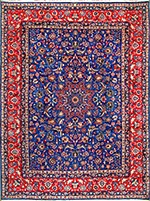Textiles Studies

Textile Research Works
Date of this Version
1987
Document Type
Article
Citation
Exhibition, The Textile Museum, Washington, D.C., November 7, 1987 - January 29, 1988
Abstract
Textiles are luxuries and necessities. They are artifacts as well as primary sources which contain a wealth of information about the society that produced them Materials and color represent products available for textile production; structure gives evidence of levels of technological achievement. Patterns illustrate belief and values, frequently offering insight into daily life. The mingling of motifs expresses a kinship of ideas. Textiles, above all, illustrate a culture's freshness and vitality, its flexibility and adaptation to change.
Meaning and Metaphor: Cultural themes occur in both Persian poetry and the textile arts. Hunting, falconry, bird-and-flower studies were popular subjects for poetry, painting and the textile arts. Favorite stories from the Shahnamah, The Book of Kings by Firdawsi, and from the Khamsah, a quintet of poems by Nizami, were carefully transferred and adapted to the rectilinear requirements of woven textiles. Moments of drama and memorable events were portrayed by painters and weavers alike. Persian textile arts express the heritage of a glorious past, displaying a sense of beauty that was an integral part of the cultural achievement of Safavid and Qajar Iran. Persian textiles figured prominently in one of the richest periods in textile history, and were sought by mercantile traders and royalty from abroad.
Included in
Art and Materials Conservation Commons, Art Practice Commons, Fiber, Textile, and Weaving Arts Commons, Indigenous Studies Commons, Museum Studies Commons


Comments
Copyright © 1987 The Textile Museum